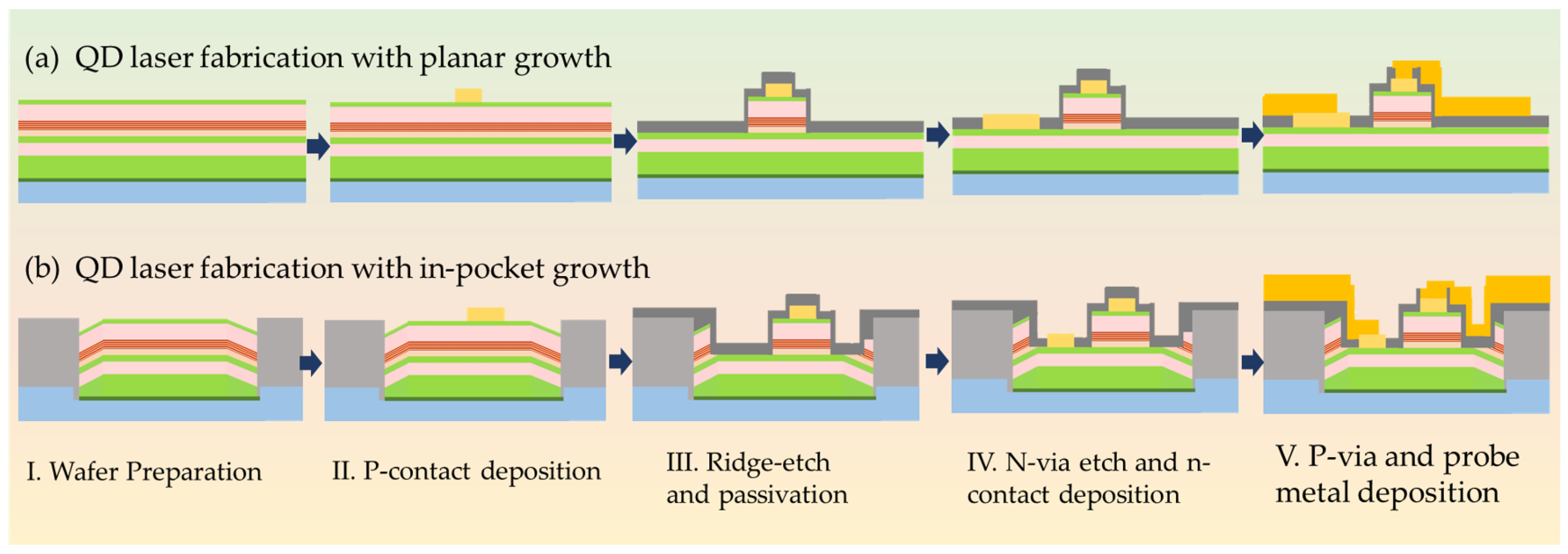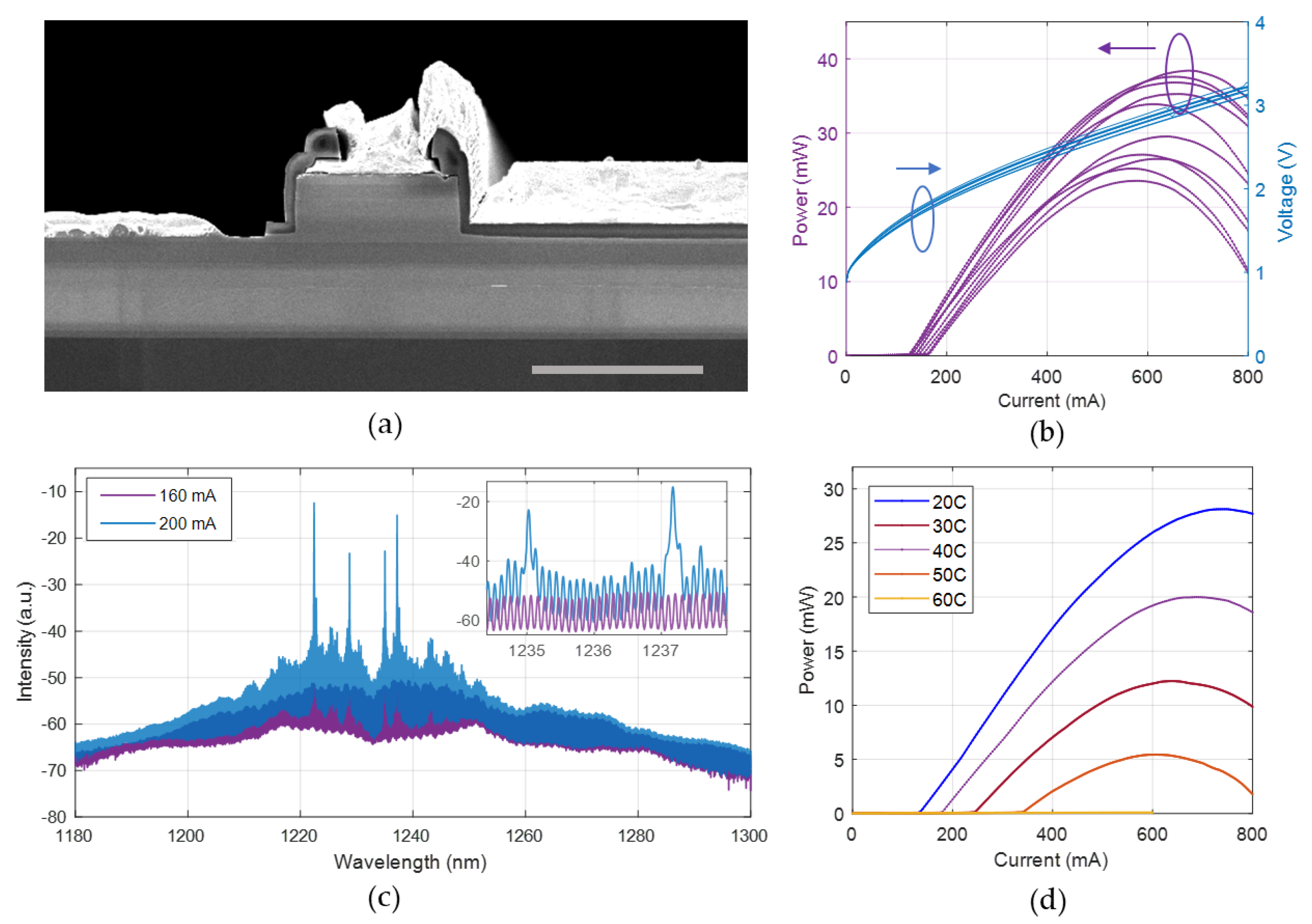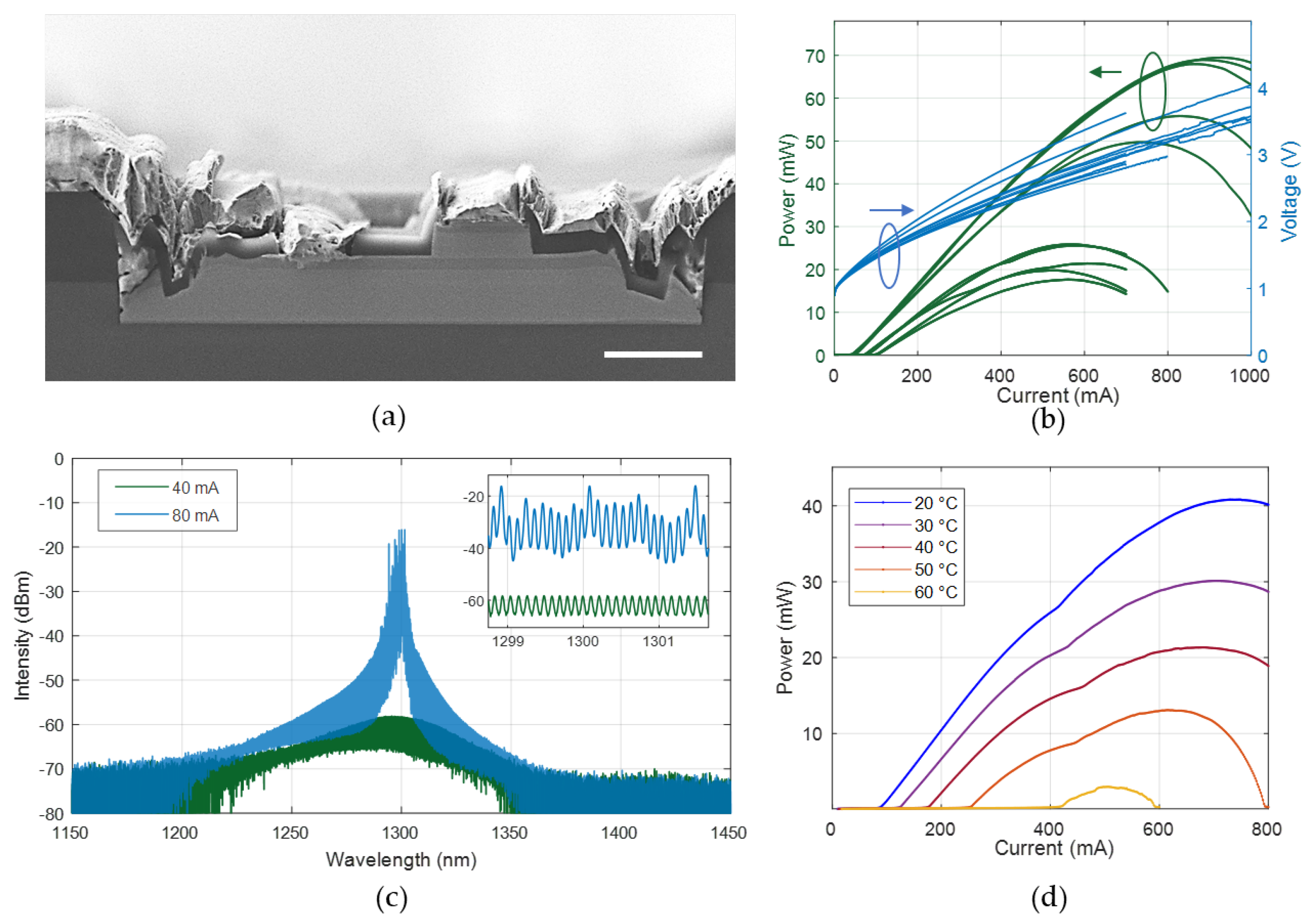Quantum Dot Lasers Directly Grown on 300 mm Si Wafers: Planar and In-Pocket
Abstract
:1. Introduction
2. Blanket Growth of Quantum Dot Lasers on 300 mm Si Wafer
3. In-Pocket Growth of Quantum Dot Lasers on 300 mm Si Photonic Wafer
4. Fabrication Process Development of Quantum Dot Lasers
5. Results and Discussion
5.1. Planar-Growth Quantum Dot Lasers
5.2. In-Pocket Quantum Dot Lasers
5.3. On-Chip In-Pocket Quantum Dot Lasers for Si Photonic Integration
5.4. Towards the Fully Monolithic Integration of Quantum Dot Lasers with Si Photonics
6. Conclusions
Author Contributions
Funding
Institutional Review Board Statement
Informed Consent Statement
Data Availability Statement
Acknowledgments
Conflicts of Interest
References
- Margalit, N.; Xiang, C.; Bowers, S.M.; Bjorlin, A.; Blum, R.; Bowers, J.E. Perspective on the future of silicon photonics and electronics. Appl. Phys. Lett. 2021, 118, 220501. [Google Scholar] [CrossRef]
- Thomson, D.; Zilkie, A.; Bowers, J.E.; Komljenovic, T.; Reed, G.T.; Vivien, L.; Marris-Morini, D.; Cassan, E.; Virot, L.; Fédéli, J.M.; et al. Roadmap on silicon photonics. J. Opt. 2016, 18, 073003. [Google Scholar] [CrossRef]
- Shi, Y.; Zhang, Y.; Wan, Y.; Yu, Y.; Zhang, Y.; Hu, X.; Xiao, X.; Xu, H.; Zhang, L.; Pan, B. Silicon photonics for high-capacity data communications. Photonics Res. 2022, 10, A106–A134. [Google Scholar] [CrossRef]
- Dumont, M.; Liu, S.; Kennedy, M.; Bowers, J. High-efficiency quantum dot lasers as comb sources for DWDM applications. Appl. Sci. 2022, 12, 1836. [Google Scholar] [CrossRef]
- Xie, W.; Xiang, C.; Chang, L.; Jin, W.; Peters, J.; Bowers, J.E. Silicon-integrated nonlinear III–V photonics. Photonics Res. 2022, 10, 535–541. [Google Scholar] [CrossRef]
- Zhang, X.; Kwon, K.; Henriksson, J.; Luo, J.; Wu, M.C. A large-scale microelectromechanical-systems-based silicon photonics LiDAR. Nature 2022, 603, 253–258. [Google Scholar] [CrossRef]
- Moody, G.; Sorger, V.J.; Blumenthal, D.J.; Juodawlkis, P.W.; Loh, W.; Sorace-Agaskar, C.; Jones, A.E.; Balram, K.C.; Matthews, J.C.; Laing, A.; et al. 2022 Roadmap on integrated quantum photonics. J. Phys. Photonics 2022, 4, 012501. [Google Scholar] [CrossRef]
- Siew, S.Y.; Li, B.; Gao, F.; Zheng, H.Y.; Zhang, W.; Guo, P.; Xie, S.W.; Song, A.; Dong, B.; Luo, L.W.; et al. Review of silicon photonics technology and platform development. J. Light. Technol. 2021, 39, 4374–4389. [Google Scholar] [CrossRef]
- Giewont, K.; Nummy, K.; Anderson, F.A.; Ayala, J.; Barwicz, T.; Bian, Y.; Dezfulian, K.K.; Gill, D.M.; Houghton, T.; Hu, S.; et al. 300-mm monolithic silicon photonics foundry technology. IEEE J. Sel. Top. Quantum Electron. 2019, 25, 1–11. [Google Scholar] [CrossRef]
- Munoz, P.; van Dijk, P.W.; Geuzebroek, D.; Geiselmann, M.; Dominguez, C.; Stassen, A.; Doménech, J.D.; Zervas, M.; Leinse, A.; Roeloffzen, C.G.; et al. Foundry developments toward silicon nitride photonics from visible to the mid-infrared. IEEE J. Sel. Top. Quantum Electron. 2019, 25, 1–13. [Google Scholar] [CrossRef]
- Fahrenkopf, N.M.; McDonough, C.; Leake, G.L.; Su, Z.; Timurdogan, E.; Coolbaugh, D.D. The AIM photonics MPW: A highly accessible cutting edge technology for rapid prototyping of photonic integrated circuits. IEEE J. Sel. Top. Quantum Electron. 2019, 25, 1–6. [Google Scholar] [CrossRef]
- Han, Y.; Park, H.; Bowers, J.; Lau, K.M. Recent advances in light sources on silicon. Adv. Opt. Photonics 2022, 14, 404–454. [Google Scholar] [CrossRef]
- Liang, D.; Bowers, J.E. Recent progress in heterogeneous III-V-on-silicon photonic integration. Light. Adv. Manuf. 2021, 2, 59–83. [Google Scholar] [CrossRef]
- Matsuo, S.; Aihara, T.; Hiraki, T.; Maeda, Y.; Kishi, T.; Fujii, T.; Takeda, K.; Kakitsuka, T. Heterogeneously Integrated Membrane III–V Compound Semiconductor Devices With Silicon Photonics Platform. IEEE J. Sel. Top. Quantum Electron. 2022, 29, 1–10. [Google Scholar] [CrossRef]
- Uzun, A.; Atar, F.B.; Iadanza, S.; Loi, R.; Zhang, J.; Roelkens, G.; Krestnikov, I.; Rimböck, J.; O’Faolain, L.; Corbett, B. Integration of Edge-Emitting Quantum Dot Lasers with Different Waveguide Platforms using Micro-Transfer Printing. IEEE J. Sel. Top. Quantum Electron. 2023, 29, 1–10. [Google Scholar] [CrossRef]
- Corbett, B.; Loi, R.; O’Callaghan, J.; Roelkens, G. Transfer printing for silicon photonics. In Semiconductors and Semimetals; Elsevier: Amsterdam, The Netherlands, 2018; Volume 99, pp. 43–70. [Google Scholar]
- Fathololoumi, S.; Hui, D.; Jadhav, S.; Chen, J.; Nguyen, K.; Sakib, M.; Li, Z.; Mahalingam, H.; Amiralizadeh, S.; Tang, N.N.; et al. 1.6 Tbps silicon photonics integrated circuit and 800 Gbps photonic engine for switch co-packaging demonstration. J. Light. Technol. 2020, 39, 1155–1161. [Google Scholar] [CrossRef]
- Shi, Y.; Wang, Z.; Van Campenhout, J.; Pantouvaki, M.; Guo, W.; Kunert, B.; Van Thourhout, D. Optical pumped InGaAs/GaAs nano-ridge laser epitaxially grown on a standard 300-mm Si wafer. Optica 2017, 4, 1468–1473. [Google Scholar] [CrossRef]
- Shi, B.; Pinna, S.; Zhao, H.; Zhu, S.; Klamkin, J. Lasing characteristics and reliability of 1550 nm laser diodes monolithically grown on silicon. Phys. Status Solidi A 2021, 218, 2000374. [Google Scholar] [CrossRef]
- Shi, B.; Song, B.; Taylor, A.A.; Brunelli, S.S.; Klamkin, J. Selective area heteroepitaxy of low dislocation density antiphase boundary free GaAs microridges on flat-bottom (001) Si for integrated silicon photonics. Appl. Phys. Lett. 2021, 118, 122106. [Google Scholar] [CrossRef]
- Yang, J.; Liu, Z.; Jurczak, P.; Tang, M.; Li, K.; Pan, S.; Sanchez, A.; Beanland, R.; Zhang, J.C.; Wang, H.; et al. All-MBE grown InAs/GaAs quantum dot lasers with thin Ge buffer layer on Si substrates. J. Phys. Appl. Phys. 2020, 54, 035103. [Google Scholar] [CrossRef]
- Zhang, Z.; Shang, C.; Norman, J.C.; Koscica, R.; Feng, K.; Bowers, J.E. Monolithic passive- Active integration of epitaxially grown quantum dot lasers on silicon. Phys. Status Solidi A 2022, 219, 2100522. [Google Scholar] [CrossRef]
- Wei, W.-Q.; He, A.; Yang, B.; Wang, Z.-H.; Huang, J.-Z.; Han, D.; Ming, M.; Guo, X.; Su, Y.; Zhang, J.-J.; et al. Monolithic integration of embedded III–V lasers on SOI. Light. Sci. Appl. 2023, 12, 84. [Google Scholar] [CrossRef]
- Wang, Y.; Ma, B.; Li, J.; Liu, Z.; Jiang, C.; Li, C.; Liu, H.; Zhang, Y.; Zhang, Y.; Wang, Q.; et al. InAs/GaAs quantum-dot lasers grown on on-axis Si (001) without dislocation filter layers. Opt. Express 2023, 31, 4862–4872. [Google Scholar] [CrossRef]
- Liu, A.Y.; Zhang, C.; Norman, J.; Snyder, A.; Lubyshev, D.; Fastenau, J.M.; Liu, A.W.; Gossard, A.C.; Bowers, J.E. High performance continuous wave 1.3 μ m quantum dot lasers on silicon. Appl. Phys. Lett. 2014, 104, 041104. [Google Scholar] [CrossRef]
- Ledentsov, N.N.; Kovsh, A.R.; Zhukov, A.E.; Maleev, N.A.; Mikhrin, S.S.; Vasil’ev, A.P.; Semenova, E.S.; Maximov, M.V.; Shernyakov, Y.M.; Kryzhanovskaya, N.V.; et al. High performance quantum dot lasers on GaAs substrates operating in 1.5 μm range. Electron. Lett. 2003, 39, 1126–1128. [Google Scholar] [CrossRef]
- Ouyang, D.; Ledentsov, N.N.; Bimberg, D.; Kovsh, A.R.; Zhukov, A.E.; Mikhrin, S.S.; Ustinov, V.M. High performance narrow stripe quantum-dot lasers with etched waveguide. Semicond. Sci. Technol. 2003, 18, L53. [Google Scholar] [CrossRef]
- Ledentsov, N.N.; Shchukin, V.A.; Kettler, T.; Posilovic, K.; Bimberg, D.; Karachinsky, L.Y.; Gladyshev, A.Y.; Maximov, M.V.; Novikov, I.I.; Shernyakov, Y.M.; et al. MBE-grown metamorphic lasers for applications at telecom wavelengths. J. Cryst. Growth 2007, 301, 914–922. [Google Scholar] [CrossRef]
- Kettler, T.; Karachinsky, L.Y.; Ledentsov, N.N.; Shchukin, V.A.; Fiol, G.; Kuntz, M.; Lochmann, A.; Schulz, O.; Reissmann, L.; Posilovic, K.; et al. Degradation-robust single mode continuous wave operation of 1.46 μ m metamorphic quantum dot lasers on GaAs substrate. Appl. Phys. Lett. 2006, 89, 041113. [Google Scholar] [CrossRef]
- Selvidge, J.; Norman, J.; Salmon, M.E.; Hughes, E.T.; Bowers, J.E.; Herrick, R.; Mukherjee, K. Non-radiative recombination at dislocations in InAs quantum dots grown on silicon. Appl. Phys. Lett. 2019, 115, 131102. [Google Scholar] [CrossRef]
- Liu, Z.; Hantschmann, C.; Tang, M.; Lu, Y.; Park, J.S.; Liao, M.; Pan, S.; Sanchez, A.; Beanland, R.; Martin, M.; et al. Origin of defect tolerance in InAs/GaAs quantum dot lasers grown on silicon. J. Light. Technol. 2019, 38, 240–248. [Google Scholar] [CrossRef]
- Jung, D.; Zhang, Z.; Norman, J.; Herrick, R.; Kennedy, M.; Patel, P.; Turnlund, K.; Jan, C.; Wan, Y.; Gossard, A.C.; et al. Highly reliable low-threshold InAs quantum dot lasers on on-axis (001) Si with 87% injection efficiency. ACS Photonics 2017, 5, 1094–1100. [Google Scholar] [CrossRef]
- Shang, C.; Hughes, E.; Wan, Y.; Dumont, M.; Koscica, R.; Selvidge, J.; Herrick, R.; Gossard, A.C.; Mukherjee, K.; Bowers, J.E. High-temperature reliable quantum-dot lasers on Si with misfit and threading dislocation filters. Optica 2021, 8, 749–754. [Google Scholar] [CrossRef]
- Shang, C.; Selvidge, J.; Hughes, E.; Norman, J.C.; Taylor, A.A.; Gossard, A.C.; Mukherjee, K.; Bowers, J.E. A Pathway to Thin GaAs Virtual Substrate on On-Axis Si (001) with Ultralow Threading Dislocation Density. Phys. Status Solidi A 2021, 218, 2000402. [Google Scholar] [CrossRef]
- Selvidge, J.; Hughes, E.T.; Norman, J.C.; Shang, C.; Kennedy, M.; Dumont, M.; Netherton, A.M.; Zhang, Z.; Herrick, R.W.; Bowers, J.E.; et al. Reduced dislocation growth leads to long lifetime InAs quantum dot lasers on silicon at high temperatures. Appl. Phys. Lett. 2021, 118, 192101. [Google Scholar] [CrossRef]
- Volz, K.; Beyer, A.; Witte, W.; Ohlmann, J.; Németh, I.; Kunert, B.; Stolz, W. GaP-nucleation on exact Si (0 0 1) substrates for III/V device integration. J. Cryst. Growth 2011, 315, 37–47. [Google Scholar] [CrossRef]
- Beyer, A.; Stegmüller, A.; Oelerich, J.O.; Jandieri, K.; Werner, K.; Mette, G.; Stolz, W.; Baranovskii, S.D.; Tonner, R.; Volz, K. Pyramidal structure formation at the interface between III/V semiconductors and silicon. Chem. Mater. 2016, 28, 3265–3275. [Google Scholar] [CrossRef]
- Shang, C.; Feng, K.; Hughes, E.T.; Clark, A.; Debnath, M.; Koscica, R.; Leake, G.; Herman, J.; Harame, D.; Ludewig, P.; et al. Electrically pumped quantum-dot lasers grown on 300 mm patterned Si photonic wafers. Light. Sci. Appl. 2022, 11, 299. [Google Scholar] [CrossRef]
- Shang, C.; Hughes, E.T.; Begley, M.R.; Koscica, R.; Fouchier, M.; Wang, F.; Dai, H.; Mukherjee, K.; Feng, K.; He, W.; et al. Design rules for addressing material asymmetry induced by templated epitaxy in pockets for on-chip heteroepitaxial light sources. ACS Nano 2023, submitted.
- Jain, S.; Sysak, M.; Swaidan, M.; Bowers, J. Silicon fab-compatible contacts to n-InP and p-InGaAs for photonic applications. Appl. Phys. Lett. 2012, 100, 201103. [Google Scholar] [CrossRef]








Disclaimer/Publisher’s Note: The statements, opinions and data contained in all publications are solely those of the individual author(s) and contributor(s) and not of MDPI and/or the editor(s). MDPI and/or the editor(s) disclaim responsibility for any injury to people or property resulting from any ideas, methods, instructions or products referred to in the content. |
© 2023 by the authors. Licensee MDPI, Basel, Switzerland. This article is an open access article distributed under the terms and conditions of the Creative Commons Attribution (CC BY) license (https://creativecommons.org/licenses/by/4.0/).
Share and Cite
Feng, K.; Shang, C.; Hughes, E.; Clark, A.; Koscica, R.; Ludewig, P.; Harame, D.; Bowers, J. Quantum Dot Lasers Directly Grown on 300 mm Si Wafers: Planar and In-Pocket. Photonics 2023, 10, 534. https://doi.org/10.3390/photonics10050534
Feng K, Shang C, Hughes E, Clark A, Koscica R, Ludewig P, Harame D, Bowers J. Quantum Dot Lasers Directly Grown on 300 mm Si Wafers: Planar and In-Pocket. Photonics. 2023; 10(5):534. https://doi.org/10.3390/photonics10050534
Chicago/Turabian StyleFeng, Kaiyin, Chen Shang, Eamonn Hughes, Andrew Clark, Rosalyn Koscica, Peter Ludewig, David Harame, and John Bowers. 2023. "Quantum Dot Lasers Directly Grown on 300 mm Si Wafers: Planar and In-Pocket" Photonics 10, no. 5: 534. https://doi.org/10.3390/photonics10050534
APA StyleFeng, K., Shang, C., Hughes, E., Clark, A., Koscica, R., Ludewig, P., Harame, D., & Bowers, J. (2023). Quantum Dot Lasers Directly Grown on 300 mm Si Wafers: Planar and In-Pocket. Photonics, 10(5), 534. https://doi.org/10.3390/photonics10050534





